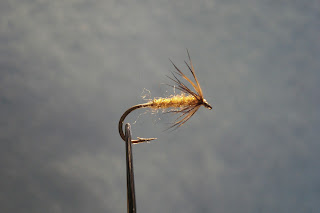Hook:
|
14-16
|
|
Thread:
|
Dark brown
|
|
Body:
|
Silk buttonhole twist – Coats and Clarke’s dark
chocolate brown 56-B, size D
|
|
Hackle:
|
Reddish-brown grouse back hackle
|
|
T. E. Pritt notes that the Sandy Moorgame, no.
43, “is a very useful fly from May to the end of July, and it is not to be
neglected in a brown water clearing after a flood. It is probably identical
with the dark dun of Theakston.” Pritt’s dressing calls for
“WINGS.-Hackled with a
dark, reddish-brown feather from the back of a Grouse.
BODY.-Dark brown silk.
HEAD.-Ditto.”
In Michael Theakston’s List of Natural Flies (1843), a “dun” is not a mayfly, but rather
a sedge or caddis; the Dark Dun n0. 50 is a caddis hatching in the late
spring or early summer“winged with a dark feather from the Moorcock;
brown silk for body; legged with a dark brown hen hackle.”
|
||
Wednesday, July 29, 2015
Sandy Moorgame; or, Dark Dun
Wednesday, July 15, 2015
Wren Tail
 |
| This dressing follows William Blacker's substitution suggestion and uses a hackle from the head of a red grouse in place on a wren tail feather. |
Hook:
|
18-20
|
|
Thread:
|
Yellow
|
|
Body:
|
Yellow thread
|
|
Rib:
|
Gold twist
|
|
Hackle:
|
Small red feather on a red grouse’s head
|
|
Historically, anglers have dressed the Wren
Tail as a terrestrial imitation for the leafhopper, which naturally exhibits
ranging in color from a drab monochromatic to a vivid, improbable patterning
of colors.
Many author anglers include dressings for a Wren
Tail pattern, but only William Blacker in the Art of Angling (1843) includes a substitute for what, today, is a
taboo hackle. He relates a Wren Tail dressing that he received from a
Devonshire angler. Dressing this fly
calls for a “hook very small (midge). Body—yellow silk, and in some specimens
a little gold twist; hackle, either the wren’s tail feather . . . or the
small red feather on the cock grouse head.” Blacker’s own Wren Trail Fly is
more involved, larger, winged dressing.
Another useful substitute for wren tail besides the red grouse neck
hackle that Blacker specifies is evident in the hackling equivalent that James
Blades listed for his Wren Tail in a list of Blades’ patterns that Robert L.
Smith included at the end of his North
Country Fly: Yorkshire’s Soft Hackle Tradition (2015), available from Coch-y-Bonddu Books: Blades dressing equates hackle “from the outside of a quail wing” with
hackling from a “wren tail.” His dressing for the Wren Tail is
“Hook: No. 1 or 0
Silk: Orange
Body: Orange silk dubbed with red fur, and ribbed with
gold
Wings: From the outside of a quail wing or wren tail
(A good fly on blustery, showery days, when the fly gets
dashing into the water from overhanging growth)”
|
 |
| This dressing of John Kirkbride’s “clear water” Wren’s Tail follows Blacker’s substitution for hackle and a mix of olive hare’s ear and medium olive antron for the body. |
John Kirkbride includes the Wren’s Tail in his
Northern Angler (1837), calling it
“an excellent summer fly. The body, if the water be somewhat black, ought to
be of light orange mohair, tipt at the tail with a little gold wire or
tinsel; or, for clear water, a dusky olive body, tipt as above, suits
extremely well; a feather from a wren’s tail must be put round the head as a
hackle.”
|
 |
| For Alfred Ronalds’ Wren Tail, this dressing also follows Blacker’s hackle suggestion and uses tan acrylic for the body. |
In the Flyfisher’s
Entomology (1836), Alfred Ronalds dresses the Wren Tail as a summer
terrestrial, the Frog Hopper or Pale Brown Bent Hopper, dressed with a
“BODY. Ginger-coloured fur ribbed with gold twist.
WINGS AND LEGS. Feather from a wren’s tail.”
|
Wednesday, July 1, 2015
Grey Partridge or Grey Watchet
Hook:
|
16-18
|
|
Thread:
|
Primrose
|
|
Body:
|
Primrose Pearsall’s gossamer silk
|
|
Hackle:
Head:
|
Partridge
Peacock herl
|
|
In North-Country
Flies (1886), T. E. Pritt distinguishes the Yellow Partridge (Grey Gnat) No. 28, “a good killer
almost any time during April,” from
the Grey Partridge (Grey Watchett),
No. 57, which he recommends dressing “for cold days, and in the evenings
during June and July”:
“WINGS.—Hackled with a
light feather from a Partridge’s breast.
BODY.—Straw-coloured
silk.
HEAD.—Peacock herl.”
W. H. Lawrie includes a Grey Partridge Spider
among his list of Border Hackled Flies in Scottish
Trout Flies (1966), dressing it with bodies of both the yellow and primrose silk of
Pritt’s Yellow and Grey Partridges. Lawrie recommends it for spring
fishing, from late April through June.
|
Subscribe to:
Posts (Atom)

